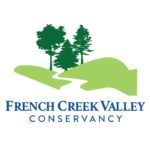Partnerships
As a land trust, French Creek Valley Conservancy works with landowners who wish to conserve forests, agricultural lands, riparian areas, wildlife habitat and unique natural areas. Protected properties help to ensure that the watershed is safely developed, wildlife and water quality are preserved, and public access is protected. Properties and easements donated or otherwise acquired by the Conservancy are stewarded and legally protected in perpetuity, thereby conserving the health, beauty and quality of life in our watershed for future generations.
French Creek Valley Conservancy works closely with the Western Pennsylvania Conservancy, The Nature Conservancy, the Pennsylvania Environmental Council, and Audubon Pennsylvania, partners composing the French Creek Conservation Collaborative that provides outreach, education and technical assistance to local communities. In addition, French Creek Valley Conservancy consults with the Allegheny Valley Conservancy, along with various state and federal agencies, local municipalities, businesses and other community conservation organizations.
Steward & Protect
Protecting the French Creek Watershed from pollution and habitat degradation is a shared mission. Regional biologists, environmental scientists, landholders, developers, residents, and visitors are stewards of the region who use education, research, and collaborative, community-based conservation activities to achieve their goals.
Threats to the Watershed and Management Best Practices
Pollution and Habitat Degradation
The greatest pollution threats in the watershed are non-point source pollution issues such as acid rain, run-off from agricultural activities, sedimentation from timbering and construction sites, impervious surface run off from rooftops, paved lots and roadways, and storm water run-off. Stream or water channel alteration also cause habitat loss or degradation in the watershed. Human activities such as farming, logging, road building, commercial and residential construction, and mining are potential risks. Invasive, exotic plant and animal species such as Japanese knotweed, purple loosestrife, hybrid cattails, zebra mussels, the round goby and the emerald ash borer also pose a potential endangerment to the health of the watershed’s natural flora and fauna.
Agriculture
Approximately 40 percent of the French Creek Watershed’s land is dedicated to agricultural use. Row cropping and pasturing along waterways have been demonstrated to increase stream bank erosion and sedimentation, impair critical riparian (streamside) buffer zones, and increase the flow of fertilizers and chemicals into local streams. Agricultural Best Management Practices (BMPs) such as no till planting, crop nutrient management, integrated pest management, stream bank fencing, and animal feeding and/or watering operations management and manure management are effective procedures that can sustain and improve water quality while maintaining effective agricultural production.
Forestry
Riparian forests stabilize stream banks, provide shade to maintain cool water temperatures, and provide food and habitat for wildlife. They also buffer the waterway against runoff from adjacent land uses. Forestry Best Management Practices include utilizing sediment barriers for runoff containment, building culverts for stream crossings, maintaining “shade strip” and “filter strip” buffer zones, and minimizing cutting on steep and unstable slopes.
Here are some links to our regional partners:
Western PA Conservancy Agricultural Services
PA Farmland Preservation Association
Pennsylvania Land Trust Association
PA Department of Conservation and Natural Resources


